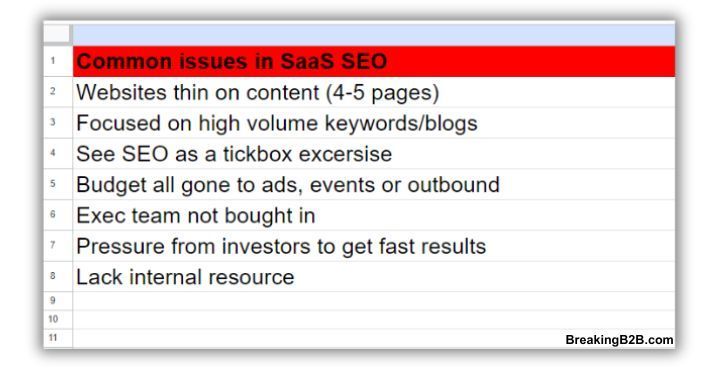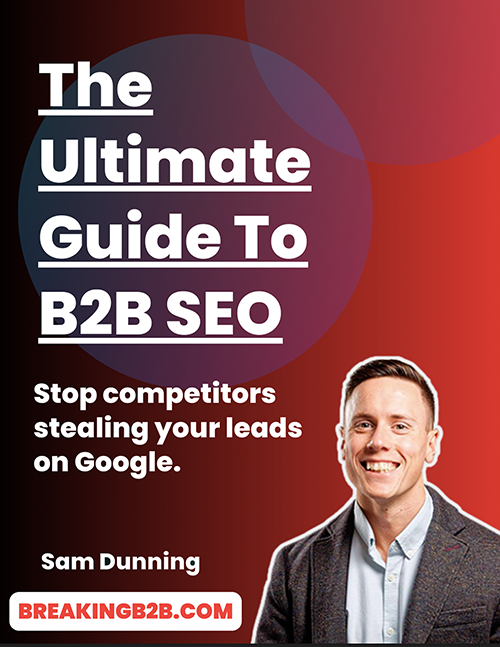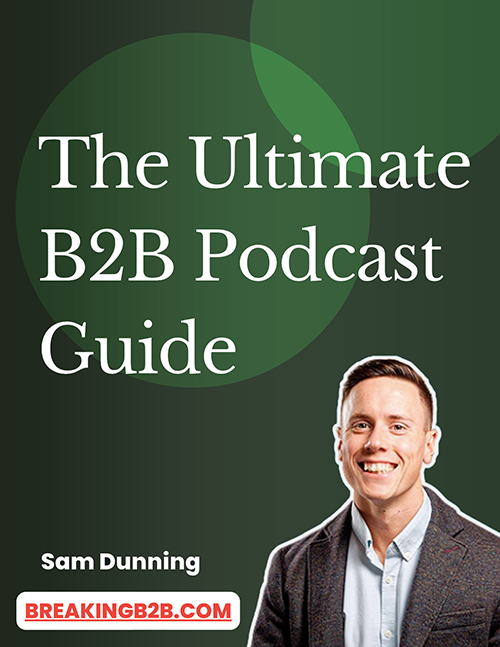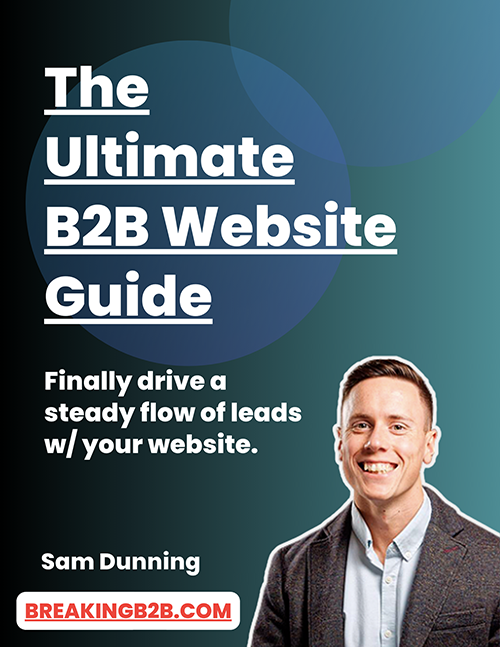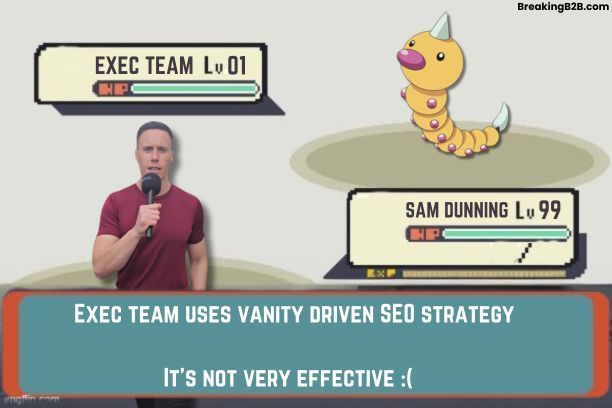Enterprise SaaS SEO Key Tactics
For Dominating Search Rankings!
Author: Sam Dunning ✪ Date: June 28th 2024
For digital businesses, standing out in search engine results is no longer just an advantage—it's a necessity. This is especially true for enterprise SaaS companies. Your customers are knowledgeable, your competitors are relentless, and the algorithms are ever-changing. In this guide, we discuss strategies that catapult SaaS giants to the top of search results. This isn't your run-of-the-mill enterprise SaaS SEO guide; it's a tailored blueprint designed to address unique challenges & opportunities in the SaaS industry.
What Is Enterprise Saas SEO?
Enterprise SaaS SEO is the practice of optimising search engine performance specifically for software-as-a-service (SaaS) companies operating on a large scale.
It involves a strategic blend of technical SEO, content marketing, and link-building tailored to the unique needs of SaaS products.
By improving search engine rankings, SaaS enterprises can attract more qualified leads, enhance brand visibility, and drive conversions. Unlike traditional SEO, enterprise SaaS SEO must account for complex sales funnels, competitive keywords, and frequently updated content.
Benefits of Enterprise SEO
Understanding the intricacies of enterprise SaaS SEO is essential, but what makes it truly valuable are the significant benefits it brings to your business.
Implementing a robust enterprise SEO strategy can lead to remarkable revenue growth, potentially doubling your B2B earnings. This isn't just about driving traffic; it's about converting that traffic into tangible revenue.
Another substantial benefit is improved brand visibility. Targeted SEO efforts ensure that your brand appears prominently in search results, making it easier for customers to find you. This heightened visibility can dominate product categories and industries, positioning you as a leader in your field.
Moreover, enterprise SEO allows you to control your online narrative, enhancing your
brand reputation. By strategically managing your online presence, you can shape public perception and build a positive image.
For more benefits and advantages of enterprise SaaS SEO >
SaaS SEO Technical Guide
Enterprise SaaS SEO Tactics
Here are some SEO tips for enterprise SaaS businesses:
1. Keyword Research
Begin by analysing user intent and search trends to understand what your target audience is looking for. This approach ensures that the keywords you select align with the needs and queries of potential customers.
Focus on both high-converting keywords and long-tail keywords. High-converting keywords often have higher competition but can bring significant traffic and conversions.
On the other hand, long-tail keywords capture specific search queries and drive more qualified leads with less competition. These keywords often reflect more detailed user intent, making them essential for attracting serious buyers.
Leverage keyword research tools and analytics to gather data on search volumes, competition, and trends. Use this data to make informed, data-driven decisions about which keywords to target.
2. On-Page SEO
i. Optimise Title Tags and Meta Descriptions
Optimising title tags and meta descriptions is crucial for boosting your click-through rates and improving search relevancy. By carefully crafting these elements, you can greatly enhance your site's visibility and attract more users from search engines.
Start by including target keywords in your title tags and meta descriptions. This practice helps search engines understand the content of your pages, making them more likely to appear in relevant searches.
Title tags should be concise, ideally between 50-60 characters, to ensure they display properly in search results. For maximum impact, include your primary target keyword near the beginning.
Meta descriptions, on the other hand, should be around 150-160 characters. These brief summaries shouldn't only incorporate target keywords but also use power words and calls to action to entice users to click on your link.
ii. Use Heading Tags Appropriately
Proper use of heading tags (H1, H2, H3) enhances your site's SEO and makes your content more accessible and easier to navigate for users. Correctly structured heading tags help search engines understand the hierarchy and structure of your content, which can boost your SEO rankings and improve user experience.
Here are four tips to help you use heading tags effectively:
- Use One H1 Tag Per Page: The H1 tag should contain your page's main topic or title. Make sure it includes your primary target keyword to signal to search engines what your content is about.
- Maintain Hierarchical Order: Follow a logical structure with heading tags. Use H2 tags for main sections and H3 tags for subsections. This hierarchical order helps both search engines and users better understand your content.
- Include Target Keywords: Incorporate relevant target keywords in your H2 and H3 tags. This practice reinforces the main topics and subtopics, making it easier for search engines to index your page.
- Improve Readability: Break up large chunks of text with heading tags. This improves user experience by making your content more scannable and easier to read.
iii. Image Optimisation (Alt Text, File Names)
Enhancing your platform’s SEO and accessibility starts with effective image optimisation. Alt text isn't just a nice-to-have; it's essential for providing descriptions to visually impaired users and search engines alike.
When you craft concise and relevant alt text, your images will be accessible to everyone. Search engines will alsounderstand and index them correctly.
Don't overlook the importance of your file names. Instead of generic names like 'IMG1234.jpg,' use keyword-rich file names that describe the image content accurately. This small step can greatly boost your image search rankings and overall SEO performance.
Proper image optimisation also means considering load times. Compressed and well-optimised images can enhance user experience by reducing load times, which is a crucial factor in SEO.
iv. Use Internal Linking Strategically
Strategic internal linking can significantly enhance your website's structure and user experience.Here's how you can use internal linking effectively:
- Distribute Link Equity: Internal links help distribute link equity throughout your site, boosting the authority of important pages. Ensure you link to high-value pages from other relevant content to spread the SEO benefits.
- Improve User Experience: Guide visitors to valuable resources with internal links. This can reduce bounce rates and increase the time users spend on your site, both of which are positive signals for search engines.
- Enhance Website Structure: A clear internal linking strategy helps create a logical website structure. This makes it easier for users to navigate your site and for search engine crawlers to discover and index your content.
- Content Relevance: Use internal links to connect related content, helping search engines understand the topical relevance of your pages.
3. Creating high-quality content
Creating in-depth content is a powerful enterprise SaaS SEO tactic that can significantly enhance your visibility and authority in the industry.
This involves producing comprehensive, high-quality articles, guides, and resources that thoroughly address your target audience's pain points and needs. By diving deep into relevant topics, you attract organic traffic and establish your brand as a thought leader.
Search engines reward such content because it provides genuine value, keeping visitors engaged and reducing bounce rates. Incorporating relevant keywords naturally and offering actionable insights can further improve your search rankings.
Moreover, in-depth content is more likely to earn backlinks from other reputable sites, amplifying your SEO efforts. To maintain engagement, utilise a conversational tone, incorporate visuals, and break up text with subheadings. This approach not only boosts SEO but also fosters trust and loyalty among your audience, driving long-term growth.
4. Implementing Schema Markup
After establishing a robust internal linking structure, implementing schema markup will further enhance your site's SEO by providing search engines with detailed information about your content.
Schema markup is fundamentally a code you add to your website to help search engines understand the context of your content more effectively. Doing this enables your site to achieve enhanced search results, boosting visibility and click-through rates.
When you implement schema markup, you provide search engines with specific details such as reviews, ratings, events, and products. This additional information can be used to generate rich snippets, knowledge graphs, and other enhanced search features that make your content stand out.
For example, users searching for a product your SaaS offers might see star ratings directly in the search results, making your link more appealing.
Using schema markup effectively allows you to highlight the most relevant aspects of your content, ensuring that search engines present your site in the best possible light. Implementing schema markup is an essential step to take
your SaaS SEO strategy to the next level.
5. Technical SEO Essentials
Mastering the intricacies of technical SEO is important for ensuring your Enterprise SaaS website ranks well and performs efficiently. Without a solid technical foundation, other SEO efforts can fall flat.
Here's a breakdown of key technical SEO essentials you should focus on:
- Optimise Website Structure
A well-organised website structure makes it easier for search engines to crawl and index your pages. Use proper URL structures, canonical tags, and make sure your XML sitemaps are up-to-date.
- Secure Sockets Layer (SSL) Certificate
Security is paramount, especially for SaaS platforms handling sensitive data. An SSL certificate encrypts data, instilling trust in your users and improving your search engine rankings since HTTPS is a ranking signal.
- Audit Technical SEO Regularly
Regularly audit technical SEO to catch crawl errors, broken links, and other issues. Tools like Screaming Frog and Google Search Console are invaluable for this..
6. Mobile Optimisation
As mobile device usage skyrockets, with users increasingly relying on smartphones and tablets for their online needs, ensuring your SaaS platform is mobile-friendly is no longer optional—it's essential.
A mobile-optimised site enhances user experience by providing faster loading times, intuitive navigation, and a responsive design that adapts seamlessly to various screen sizes. This not only reduces bounce rates but also boosts user engagement and satisfaction.
Google's mobile-first indexing further underscores the importance of mobile optimisation. This means Google predominantly uses a site's mobile version for indexing and ranking, making it crucial for SaaS enterprises to prioritise their mobile presence.
A well-optimised mobile platform can boost search engine rankings, driving more organic traffic and potential leads.
Moreover, mobile optimisation can significantly improve accessibility, allowing users to interact with your SaaS offerings anytime, anywhere. This convenience can enhance customer retention and brand loyalty.
7. Page Speed Enhancements
To further enhance your mobile optimisation efforts, focus on improving page speed, which directly impacts user experience and conversion rates. Google's Core Web Essentials, including metrics like Largest Contentful Paint (LCP) and Cumulative Layout Shift (CLS), are crucial for evaluating page speed and stability.
Here are three actionable steps to enhance your page speed:
- Reduce Server Response Time: A slow server response can greatly affect page speed. Use a reliable hosting service and consider implementing a Content Delivery Network (CDN) to distribute content efficiently.
- Leverage Browser Caching: Implement browser caching to store static files so that users don't need to re-download them each time they visit your site. This can significantly accelerate page loading times.
- Minimise JavaScript and CSS: Reduce the number of JavaScript and CSS files by combining them. Minify these files to remove unnecessary characters, improving both LCP and CLS..
8. Link-Building Strategies
High-quality link-building strategies can greatly enhance your enterprise SaaS SEO by boosting domain authority and search engine rankings.
Here are four effective tactics to contemplate:
- Guest Posting: Look for reputable industry websites and blogs where you can contribute articles. Guest posting helps you gain high-quality backlinks and positions you as an authority in your field.
- Outreach Campaigns: Develop targeted outreach campaigns to connect with influencers and industry experts. Building relationships with these key figures can lead to organic backlinks and increased online visibility. Personalised emails and collaborations can be particularly effective.
- Create Shareable Content: Invest time in creating valuable, shareable content such as infographics, case studies, and research reports. When your content is informative and engaging, other websites are more likely to link back to it, naturally increasing your backlink profile.
- Monitor Backlink Profiles:
Regularly analyse your backlink profiles to verify the quality and relevance of incoming links. Tools like Ahrefs or SEMrush can help you track and evaluate the effectiveness of your link-building efforts, allowing you to make necessary adjustments.
9. Leveraging Social Media
Social media platforms like LinkedIn, Facebook, and X are essential tools for reaching your target audience. By sharing content and engaging with users, you can boost your brand's credibility and visibility. Remember, 71% of consumers are more likely to recommend a brand after a positive experience on social media.
Social media marketing is a powerful way to promote your SaaS product. Strategically crafted posts and ads can attract potential customers and drive them to your website. Additionally, leveraging social media for customer support can strengthen relationships with your users.
Given that 63% of customers expect companies to offer support through social channels, timely and helpful responses can foster loyalty and satisfaction.
Don't forget about social media listening tools. These tools help you monitor brand mentions, track competitors, and identify industry trends. By understanding your target audience's preferences and behaviours, you can create more targeted and effective marketing strategies. Integrating these insights into your SEO efforts ensures you stay ahead in the competitive SaaS industry.
10. Online Reputation Management
To maintain a solid online presence, consistently monitor and manage your brand's online reputation. Enterprise SaaS companies need to control the narrative surrounding their brand. By keeping a close eye on online reviews, customer feedback, and social media mentions, you can guarantee that your brand perception remains positive.
Here are four key steps to effective online reputation management:
- Monitor Reviews and Mentions: Regularly check platforms where customers leave reviews and mentions, such as Google Reviews, Yelp, and social media. This helps you stay informed about what's being said about your brand.
- Address Negative Feedback: Respond to negative feedback promptly and transparently. Acknowledging issues and offering solutions builds trust and credibility with your customers.
- Promote Positive Content: Use SEO strategies to highlight positive content, such as customer testimonials and success stories. This can help suppress any negative information and enhance your brand perception.
- Engage Proactively: Don't wait for feedback to come to you. Actively engage with your customers through surveys and direct interactions. Collecting and showcasing positive feedback can improve your online reputation.
11. Local SEO Tips
Optimising your local SEO can significantly enhance your brand's visibility and credibility in specific regions. Begin by ensuring your NAP consistency—your Name, Address, and Phone Number should be identical across all platforms. This consistency helps search engines trust your information and improves your ranking.
If your business has multiple locations, treat each one like a unique entity. Create separate local listings for each location on platforms like Google My Business and Yelp. Detailed and accurate listings improve your visibility and help attract local customers.
Effective local citation management is another key component. Make sure your business is listed on relevant local directories and industry-specific sites. The more consistent and widespread your citations, the more credible your enterprise appears.
Don't forget customer reviews; they're important for building trust. Encourage satisfied customers to leave positive reviews on your local listings. Respond to reviews promptly to show you care about customer feedback.
12. Future SEO Trends
Future SEO trends will be shaped by AI-driven search experiences, zero-click searches, and the need for answer engine optimisation. As search engines evolve, so must your SEO strategies to stay competitive in the terrain of enterprise SaaS.
- AI-Driven Search Experience: Search engines like Google's SGE are using AI to deliver concise and valuable content. This means you need to focus on creating high-quality, user-centric content that aligns with AI algorithms.
- Zero-Click Searches: With 57% of mobile and 53% of desktop users engaging in zero-click searches, optimising for featured snippets and quick answers is essential. Your content should be rich and in-depth to capture these no-click interactions.
- Answer Engine Optimisation (AEO): As voice search and conversational queries grow, optimising your content to provide the best answers is vital. This involves creating content that directly addresses common user queries effectively.
- Evolving Search Engine Ranking Factors: Adapting to factors like historical keywords, backlinks, and mobile usability is critical. Stay updated on algorithm changes and make sure your content and technical SEO strategies are up-to-date.
Mastering enterprise SaaS SEO isn't just about increasing traffic; it's about driving meaningful conversions. While generic strategies might yield results, tailored approaches will skyrocket your success.Think of it as the difference between a crowded market stall and a bespoke boutique.
For more on the future of SEO please take a look at my > B2B SaaS SEO Checklist
Enterprise SaaS SEO FAQs
Ready To Grow Your B2B Company?

